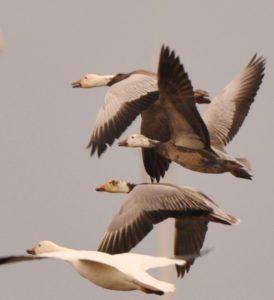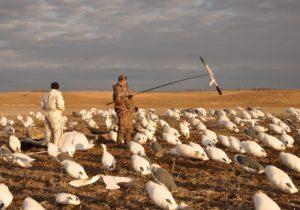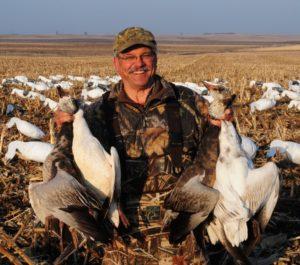Photography courtesy of Lowell Washburn, all rights reserved.
The annual mass migration of snow geese is one of creation’s most amazing spectacles. More than six million of the snow white birds are currently moving toward ancestral breeding grounds on the sodden tundras of the Canadian arctic. The northbound geese are unaware, of course, that nesting areas will remain locked under snow and ice until early to mid-June. All they know, is that it is time to fly north. Pushing the edge of the snow line, migrating birds are often forced to make a sudden U-turn as spring snowstorms force a temporary retreat. Nevertheless, the first big flocks of snow geese usually appear in Northern Iowa sometime between the 15th and 20th of March.
Of all the waterfowl that migrate across our state, no species has undergone more dramatic changes than the modern-day snow goose. I began hunting waterfowl with my dad in 1959, and bagged my first snow goose along Clear Lake’s north shore in 1964. At that time, snow geese were an important Iowa game species during a short period each fall. Peak migrations arrived in Northern Iowa around the 20th of October, and most birds had departed for the south by mid-November. No Canada geese nested anywhere in Iowa at that time; and for a hunter to shoot a migrating Canada goose was an extremely rare occurrence. So rare, in fact, that bagging a “Canadian Honker” would get your picture pasted on the front page of virtually any hometown newspaper.
By contrast, snow geese could become abundant during fall migration. There were light birds and dark birds which, at that time, we referred to as “snows & blues”. As it turned out, they were the same species. The “blue geese” were actually just a darker [blue] phase of the white snow geese.
Contemporary goose hunters would scarcely recognize the snow geese of yesteryear. Fresh from the arctic, the snow geese of the 1960s and 1970s were tame and naïve. There were no massive flocks during fall migration. Instead, the birds arrived in family groups, or in mixed flocks of twenty to thirty birds. Serious goose hunters rarely used more than one or two dozen floating decoys, and the geese were drawn to those decoys like cats to catnip. Even after being shot at, the birds would sometimes turn around and come right back into the spread for a second time. Although I never heard of anyone hunting over field decoys in North Iowa during that time, a lot of hunters would attempt to crawl into shotgun range as the birds fed in harvested corn fields. This was extremely productive. Ventura’s Roger Wilson once got off three good shots at a flock before the feeding snow geese reluctantly took wing. The event was even more amazing when you consider that Roger was using a single shot shotgun and had to stop and reload between each shot.
 Somewhere along the line, things changed; and they changed in a big way. Snow geese began migrating in larger and larger groups. Flocks now numbered into the tens of thousands and migration paths began shifting westward – so much so that today, southbound snow geese are rarely encountered in North Central Iowa. Finding safety in numbers, birds began surviving longer until geese living a decade or more became commonplace. No longer tame and naïve, flyway veterans became harder and harder to fool. As snow goose survival continued to escalate, populations exploded. Numbers became so great that grazing snow geese were soon destroying vast portions of their arctic breeding habitats. In an attempt to reduce and stabilize ever burgeoning populations, the U.S. Fish & Wildlife Service initiated a spring hunting season — a measure that had been considered unthinkable since the great waterfowl declines of the early 1900s.
Somewhere along the line, things changed; and they changed in a big way. Snow geese began migrating in larger and larger groups. Flocks now numbered into the tens of thousands and migration paths began shifting westward – so much so that today, southbound snow geese are rarely encountered in North Central Iowa. Finding safety in numbers, birds began surviving longer until geese living a decade or more became commonplace. No longer tame and naïve, flyway veterans became harder and harder to fool. As snow goose survival continued to escalate, populations exploded. Numbers became so great that grazing snow geese were soon destroying vast portions of their arctic breeding habitats. In an attempt to reduce and stabilize ever burgeoning populations, the U.S. Fish & Wildlife Service initiated a spring hunting season — a measure that had been considered unthinkable since the great waterfowl declines of the early 1900s.
Modern-day snow geese have become the wariest birds in the sky. Successfully hunting them presents an extraordinary challenge. Instead of one or two dozen decoys, today’s hunters routinely employ several hundred; and enthusiasts often pool their resources to place upwards of 1,500 or more. Dealing with extreme conditions which include muddy fields, changing winds, and geese that have seen it all during a dozen or more round trip migrations — spring goose hunts are not for the faint of heart. It’s back breaking work and the rewards are often few and far between as flock after flock of highly educated geese snub the spread. It’s nothing out of the ordinary for hunters to begin setting out hundreds of decoys at 4 or 5 am, stay out all day, have thousands of passing geese inspect and then shun their spread and, come sunset, leave the field empty handed.
But there are days when things may take an unexpected turn for the better. One such memorable occasion occurred for me a couple of years ago. It was the third week of March; skies were clear, wind out of the southwest. Although I hadn’t seen a single goose by mid-morning, it was an ideal migration day and I remained optimistic. Off in the distance, I suddenly spotted a gnat-like swarm of birds two or three miles distant. Grabbing the binoculars, I quickly determined that the “gnats” were a flock of about 150 snow geese. Better yet, they already appeared to be locked on to the spread of snow goose wind socks surrounding my position. The geese kept coming and at a distance of 100 yards, the birds simultaneously set their wings. Although I knew the geese would probably pull up again before coming in range, I would enjoy the show while it lasted. The geese stayed their course and, instead of flaring, they actually began lowering the landing gear. Before long, the flock’s shrill yelping had become deafening. The birds crossed the thirty yard line. I let them keep coming until the lead birds were touching down around me. The closest geese were standing within feet and sky remained clogged with nosily descending fowl. Making the most of this rare opportunity, I tried to “line up” two birds for the first shot. I found them and fired. To my amazement, three geese fell from the flock, and I managed to bag two more as the birds retreated. Five minutes later, another flock containing upwards of 200 snows appeared from the south. Incredibly, these birds also came directly into the decoys without so much as a preliminary swing and I bagged three more. The flight continued, and I was able to take a total of 11 snow geese by morning’s end. The best part was that all shots were within 15 yards or less. The next day found me lying in the same decoys with the exact same wind. The incredible snow goose migration continued, but it was back to normal as flock after flock only glided to within 40 yards or so before lifting up and continuing their journey. I probably had more than 2,000 geese inspect the decoys. Never fired a single shot all day. That’s how it often is with modern-day snow geese. The birds have become smarter than the people who hunt them. Ouch!





 Tom Cope
Tom Cope Sue Wilkinson
Sue Wilkinson Susan Judkins Josten
Susan Judkins Josten Rudi Roeslein
Rudi Roeslein Elyssa McFarland
Elyssa McFarland Mark Langgin
Mark Langgin Adam Janke
Adam Janke Joe Henry
Joe Henry Kristin Ashenbrenner
Kristin Ashenbrenner Joe Wilkinson
Joe Wilkinson Dr. Tammy Mildenstein
Dr. Tammy Mildenstein Sean McMahon
Sean McMahon